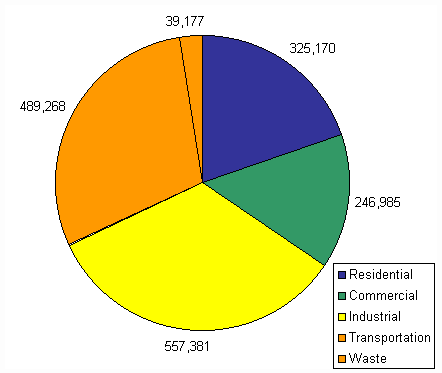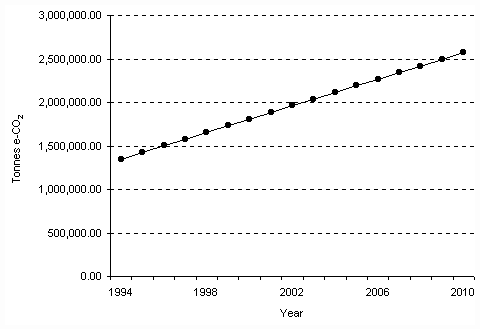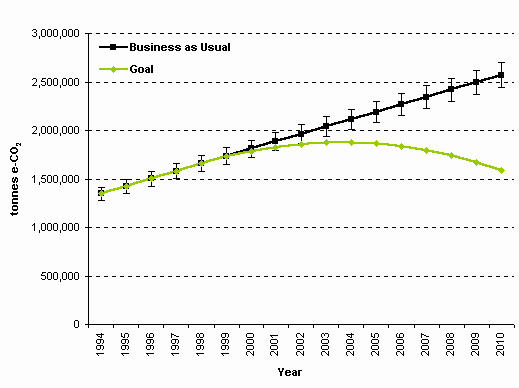| |
Download Energy Savings Calculators (MS Excel format)
. |
What
is it?
| The greenhouse
effect occurs naturally. Greenhouse gases in
the atmosphere - like carbon dioxide and methane
- trap some of the sun's heat to keep the earth
warm.
But because of human activities, the increasing
amount of greenhouse gases in the atmosphere
means more of the sun's heat is being
trapped, causing global climate change.
This climate change is what is also known
as the greenhouse effect.
|

|
|
What do we
know so far?
The consensus
amongst the scientific community is that the
enhanced greenhouse effect is very real. A report
released in 2001 by the Intergovernmental Panel
on Climate Change (IPCC), made up of hundreds
of scientists from all over the world, concluded:
"The
balance of evidence suggests a discernible human
influence on global climate".
It is also possible that current levels of
carbon dioxide in the atmosphere haven't been
exceeded for the last 20 million years.
. |
| If we continue
without reducing our emissions of greenhouse
gases, the IPCC predict a global increase in average
temperature by up to 5.8oC in the next
100 years. This increase would result in: |
"…the 1990s was the warmest decade and 1998
the warmest year in the instrumental record,
since 1861". |
- increases in sea level, droughts, floods
and extinction of species;
- the spread of deserts and loss of agricultural
land; and
- spread of vector-borne diseases - such as
malaria or Ross River Virus.
What
about Maroochy Shire?
Australia is the one of largest emitters
of greenhouse gases per head in the world and
we here in Maroochy Shire certainly contribute.
The Maroochy Shire Council undertook an inventory
of greenhouse gas emissions in 1998 (shown in
figure 1) and if we did not do anything to slow
our emissions of greenhouse gases, they would
increase significantly in line with the growth
of the Shire (as shown in figure 2).

Figure
1. Emissions of greenhouse gases (tonnes of
carbon dioxide equivalents) per sector from
the Maroochy Shire in 1998.
"There has been widespread retreat of mountain
glaciers in non-polar regions during the 20th
Century"

Figure 2. Inventories
of greenhouse gas emissions (carbon dioxide
equivalents) from Maroochy Shire were carried
out for 1994 and 1998 and a "Business as Usual"
projection made for 2010.
Can we
stop it?
There have already been consequences of global
warming - the shrinking of ice sheets and glaciers
and an increase in global average sea level
by 10-20cm. Because of how long greenhouse gases
live in the atmosphere, the effect of what we
have already emitted will last for hundreds
of years. But it doesn't have to get worse.
What
can I do?
In 1998, an amazing 1.7 million tonnes
of greenhouse gases were emitted from the Maroochy
Shire. But there are plenty of things that you
can do to help reduce this total and often save
money at the same time.
- When you're not in the room, turn the lights
off. And when you are in the room, ask yourself
whether you need the lights on or whether
there is enough natural light for what you
are doing.
- As your light bulbs die, buy energy efficient
ones. They cost more up front, but they save
a lot of money, electricity and greenhouse
emissions over the long run.
- When you can, use your microwave
oven in preference to less energy efficient
means of cooking and re-heating.
- When it's hot, close your blinds
when you leave the house in the morning. Otherwise
the sun gets in and heats up your house all
day. Then you come home and have to put the
air conditioning on!!
- When it's hot, open windows and doors in
opposite walls for cross-ventilation
and use fans in preference to air conditioners
as they require more electricity to run.
- In Winter, leave the blinds open
on the north and west sides
of your home to let the sun in, but leave
blinds closed in other parts of the house
because they add insulation value to your
windows. When the sun starts to go down, close
all the blinds to keep the day's heat in over
night. You may still need your heater, but
not quite so early in the evening.
- Instead of leaving your TV or stereo in
"stand-by" mode, turn them off.
Every item in "stand-by" mode creates about
90 kilograms of greenhouse emissions a year.
- Be careful to manage your water usage
- getting water to and from homes is one of
Council's most energy consuming activities,
accounting for nearly half of our greenhouse
gas emissions. For example, turn the tap off
while brushing your teeth; if you really need
to water your garden; limit watering to just
before sunset; use water efficient plumbing
fittings such as cisterns, taps and shower
roses; take shorter showers; etc.
- Subscribe to a renewable energy program
such as "Earth's Choice" from Energex, where
they will guarantee that the amount of electricity
you buy from them will be produced from renewable
sources such as solar and wind.
- When buying new appliances for home, the
office or wherever, choose energy efficient
ones.
- Best not to use if you’re unsure of
source/accuracy. When buying a new car, seriously
consider the fuel type (eg. LPG instead
of unleaded) and fuel consumption and ask
yourself whether you really need that larger
vehicle. Keeping your fuel bill down means
keeping your greenhouse gas emissions down.
- Organise a car pool for travelling
to and from work.
- Plan your trips more efficiently
so that you can make fewer of them or make
fewer detours.
- Buy locally made goods - they need
less transport to get to you.
- Buy goods with less or no packaging - think
about how much energy goes into packaging.
- Install a solar or heat-pump hot
water system and/or a solar photovoltaic electricity
generation system on your roof. There are
government subsidies to help with the costs
of these technologies.
| This is certainly
not an exhaustive list. There
are so many things you can do to help
reduce our impact on global climate
change and some of these help your budget
stretch further at the same time.
It's a win-win situation. |
"… global average sea level rose between
0.1 and 0.2 metres during the 20th
century" |
Think of some more things you can do to reduce
greenhouse gas emissions. This will be easy
if you can stay conscious of your environmental
impact with all things you do.
Build
an environmental home
There are plenty of things we can all do to
reduce our impact on climate change and when
we're building a new house, we can do more again.
In addition to wanting a house we can fondly
call "home", we need to consider our home's
impact on the environment. Here's some
reasons why:
Energy
The average Australian house produces between
8 and 18 tonnes of greenhouse gases
each year - those gasses which are contributing
to global climate change. Saving our use of
electricity generated from fossil fuels (where
the majority of our electricity comes from now),
can reduce these greenhouse gas emissions substantially.
Cumulatively, savings nation-wide can be enormous.
These savings would not only decrease our impact
on global climate change, but have the spin-off
benefit of reducing our electricity bills.
Waste
On average, people in Queensland produce over
800kg of waste each year, most of which
ends up in landfill. Most of this "waste" is
not waste at all. Much of it can be reused or
recycled. In fact, a lot of it doesn't need
to be used in the first place! We can reduce
the amount of waste going to landfill by:
- reducing waste at the point of purchase
by, for example, choosing products with less
packaging (or at least less non-recyclable
packaging);
- reusing waste by, for example, composting
organic and green waste such as food scraps
and lawn clippings; and
- recycling waste - sorting our litter and
actively recycling as much of it as possible.
Water
On average Queenslanders use 635 litres
of water every day. It makes environmental
and economic sense to reduce our water usage.
Saving water, by using it more sensibly, will
defer or perhaps avert the need to build new
dams and will reduce expenditure on storing,
treating and distributing water. Hence, governments
can save money and household water charges can
be kept down.
Biodiversity
Biodiversity is essential in the maintenance
of all life on earth, yet Australia's record
on losing biodiversity since 1788 has been very
poor with the highest number of vascular
plant (eg trees and shrubs) and mammal extinctions
in the world. We also have one of the highest
rates of threatened species in the world. There
are numerous factors which contribute to this,
but one of these is urban sprawl and its range
of associated environmental problems.
Urban development is inherently unsustainable,
however, in the short-term, we have an opportunity
to decrease our impact substantially. We can
do this by designing homes to fit within
an environment and by landscaping and
planting to encourage life to grow.
Getting
government support for environmental features
at home
Maroochy Shire Council, through Maroochy Water
and WaterWise, is offering a Water Conservation
Rebate Scheme to Shire residents within
the water reticulated area who install water
efficient products:
- The AAA Shower Rose Rebate is available
for residents who install a AAA-rated shower
rose in their home. The maximum rebate is
$20.
- The Rainwater Tank Rebate is available for
residents who install a rainwater tank on
their premises. Rebates are between $20 and
$250, depending on the size of the tank installed.
The Queensland State Government, through the
Environmental Protection Agency,
offers Renewable Energy and Solar Hot Water
Rebate Schemes:
Renewable Energy Rebate Schemes include:
- The Photovoltaic Rebate
Program (PVRP) for installations of PV
systems,
- The Renewable Energy Diesel
Replacement Scheme (REDRS) for installations
of renewable energy systems and equipment
in off-grid areas, and The
Working Property Rebate Scheme (WPRS)
for family-owned working properties located
in regional Queensland not connected to the
electricity grid. It assists with the installation
of Stand-alone Power Systems (SPS) [also known
as Remote Area Power Supply (RAPS) Systems].
- The Solar Hot Water Rebate Scheme
is aimed at increasing the use of domestic
solar hot water heating throughout Queensland.
The Federal Government, through the Australian Greenhouse Office,
also offers rebates for renewable energy technologies
including the Photovoltaic Rebate Program (PVRP),
which is available for households or community-use
buildings installing grid-connected or stand-alone
photovoltaic systems. (This rebate information
was current as of October 2002. For the most
recent information please call 1300 369 388
or visit the EPA website.)
The
Maroochy Greenhouse Program
| In
1998, Maroochy Shire Council joined
an international program called Cities for Climate
Protection (CCP) which helps local
government authorities all over the
world to implement strategies to reduce
greenhouse gas emissions. Since
joining the program, Maroochy Shire
Council has established the Maroochy
Greenhouse Program. |
"The
present [atmospheric] CO2
concentration has not been exceeded
during the past 420,000 years and
likely not during the past 20 million
years"
|
The objectives of the Maroochy
Greenhouse Program are:
- to
decrease the emission of greenhouse
gasses by reducing the need and use of energy
produced by burning fossil fuels
- to
promote the use of renewable energy
sources
- to
attain culture change where energy
considerations pre-empt personal actions
- to
lead by example
Progress
so far
The Maroochy Greenhouse Program has so far:
- carried out an inventory of emissions from
the Shire
- established greenhouse gas emissions reduction
targets
- developed an action plan to reach those
targets, and
- implemented an overseen a range of projects
aimed at reducing emissions from within and
from outside of the Maroochy Shire
Our goal is to reduce greenhouse gas
emissions from the Maroochy Shire to
5% below 1998 levels by 2010 (shown in figure
3 below). For Council's own operations, we aim
to bring our greenhouse gas emissions down to
20% below 1998 by 2010.

Figure 3. A comparison of greenhouse
gas emissions (carbon dioxide equivalents) from
Maroochy Shire between the "Business as Usual"
scenario and the target set by Maroochy Shire
Council for 2010.
The Maroochy Shire Greenhouse Action Strategy
was endorsed by Council in 2000 and sets the
path to further reductions in greenhouse gas
emissions until 2010 and beyond.
Where
else can I get information?
All quotes on this
page have been taken from the United
Nations Intergovernmental Panel on Climate Change
reports "Climate Change 2001: The Scientific
Basis" and "Climate Change 2001: Impacts, Adaptation
and Vulnerability".
Other related web sites include:
|
|
| |
|

